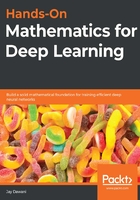
Substitution rule
Obviously, being able to find the antiderivative of a function is important, but the anti-differentiation formulas do not tell us how to evaluate every type of integral—for example, what to do when we have functions such as the following one:

This isn't as straightforward as the examples we saw earlier. In this case, we need to introduce a new variable to help us out and make the problem more manageable.
Let's make our new variable u, and  , and the differential of u is then
, and the differential of u is then  . This changes the problem into the following:
. This changes the problem into the following:

This is clearly a lot simpler. The antiderivative of this becomes the following:

And by plugging in the original value  , we get the following:
, we get the following:

And there we have it.
This method is very useful, and works when we have problems that can be written in the following form:

If  , then the following applies:
, then the following applies:

That equation might be looking somewhat similar to you. And it should. It is the chain rule from differentiation.